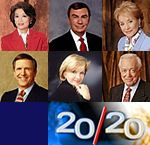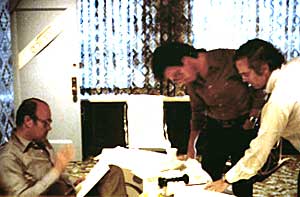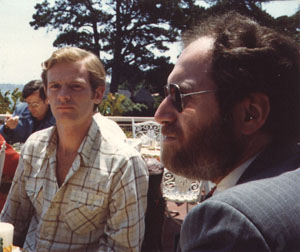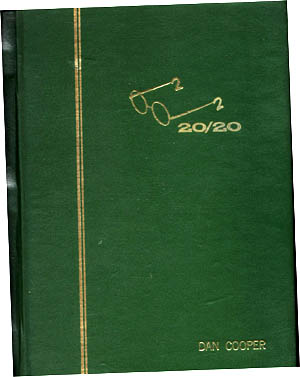. . |
 20/20 was the first weeknight prime time news magazine, and I
was there from the first day of start-up. 20/20 was the first weeknight prime time news magazine, and I
was there from the first day of start-up. |
|
| I had been working at WABC's Eyewitness News as Assistant News Director. Word was going around that ABC was going to launch a prime time news magazine. This was before Roone Arledge took over news. I was called up to GM Ken McQueen's office, where I was advised that I ought to contact Bob Shanks, who had been chosen as executive producer. I did, and I brought Bob a pile of tapes to look at, hoping to land a job as a segment producer. | ||
| Bob told me my stuff was the best he had seen, and he offered me the job I wanted. I began work with the rest of the staff right after New Year's 1977. | ||
 From left to right, Sander Vanocur, me, Bob Shanks. From left to right, Sander Vanocur, me, Bob Shanks. |
||
| The 20/20 story is book length, and well worth a book, but this is no place to tell the whole story. | ||
| My first six months consisted of creating bank pieces and helping prepare for the premiere. The staff was nothing like it is today, and nothing like anything ever put together. It was Bob Shanks' proclivity to take a fresh approach to everything he did, and he did 20/20 with a vengeance. | ||
| Bob, an impeccably mannered, thoughtful man, found himself in an awkward situation. Halfway through start-up, Roone took over news. Fred Pierce, then president of ABC, had chosen Bob, not Roone. Bob fell into that most dangerous of career traps: not invented here. | ||
| It was a tense time. On the one hand, the weirdest decisions were being made. As hosts, Bob chose Harold Hayes and Robert Hughes. Hayes, the editor of Esquire magazine in its 1960's heyday, wore three piece suits, two tone shoes, and spoke with a Carolina accent. Hughes, a European cut dandy from Australia, then art editor of Time Magazine and not yet widely known as he is today, spoke with a thick Australian accent. | ||
| Shanks decided to have them co-anchor, but with each reading half a sentence, which would be concluded by the other. The rehearsal tapes were a mess. | ||
| Geraldo Rivera, Dave Marash, Sylvia Chase, Sander Vanocur, and a brilliant but out-of-nowhere Tom Hoving and Carl Sagan were correspondents. Hoving had been curator of the Metropolitan Museum in New York; Sagan, of course, the late brilliant astronomer. | ||
 Sylvia Chase at the 20/20
offices in 1978. Sylvia Chase at the 20/20
offices in 1978. |
||
 Dave Marash on location
with me in San Francisco in 1978. At left is PA Joel Buchwald. Dave Marash on location
with me in San Francisco in 1978. At left is PA Joel Buchwald. |
||
| The delightful director, Jorn Winther, came from The Carol Burnett Show. The rest of the crew was just as wacky a combination. | ||
| By the time we got to premiere, on June 8, 1978, Bob's vision, such as it was, had been put into the Mixmaster with Roone's ideas. Bob and Harold, who was also senior producer, planned to destroy Ted Kennedy's nascent presidential bid by conducting a 6 month investigation of Chappaquidick by three leading investigative reporters. When the smoke cleared, one of them, Lowell Bergman, of "The Insider" fame, summed up the findings: "a traffic accident." | ||
| Simultaneously, Roone decided to send Sam Donaldson to Washington for a live grave site adoration of John F. Kennedy. | ||
 An original 20/20 leatherbound script book. An original 20/20 leatherbound script book. |
||
| At midnight, the night before the premiere, the whole thing had become such a botch that Robert Hughes, Dave Marash, Vanocur, a few others, and me, went on strike, adjourning to the bar at the Cafe Des Artistes. Shanks came over and asked us to get back to work, and we eventually did. [Click here to read a letter to the editor of New York Magazine for more details.] | ||
| The first show became a hodge-podge of animated political cartoons, Geraldo's report on the training of greyhounds for racing by letting them chase and catch live rabbits, an incoherent opener called The Wayward Week, a bumper feature called Words--the first was a dictionary definition of "avuncular," and much, much more. | ||
| It was a disaster, but out of it came a promotion for me, to broadcast producer. And now, though I'd love to build a web site dedicated to the early history of 20/20, I'll get back to briefly running down my accomplishments. | ||
| Shanks left after six months, looking like he had shrunk 5 inches, stooped over, exhausted and defeated. For three weeks, Jeff Gralnick was dropped in, but it quickly became clear that he didn't have the attention span to work in long form. Gralnick left, summoning me, Dennis Sullivan and Brock Brower to a final meeting. He told us we would be running 20/20 in the absence of an executive producer. Presently, Roone would pick one. But that would come six months later. | ||
| This became known as the period of the "triumvirate." Brower, formerly a veteran Life Magazine political writer, concentrated on the story list. "Let's vet the list" became his daily mantra. Brock also wrote the line "We're in touch, so you be in touch." But Brock most delighted me when, in a surge of paranoia, he showed up for work not in his usual pushed up sleeve oxford shirt, but wearing a crisp new khaki safari jacket, identical to the one worn by Roone Arledge every day. Brock wore it until he left, hoping he would be spared the obviously impending slaughter. Dennis and I arm-wrestled daily over running the show, which we aired monthly for six months. Overall, the period was a nightmare. Our pieces were reviewed by Roone, David Burke and Dick Wald, all of whom expressed exasperation at our work product. I will never forget these sessions, which included a Lowell Bergman and Dave Marash piece about marijuana having become the largest cash crop in several states, including California and Hawaii. None of the bosses believed it. The piece was years ahead of other journalism on the subject, and Wald accused us of being "out of our minds." Nevertheless, we held the show together and produced excellent programming, but with an insecure Roone, an always nasty Burke, and a pompous Wald overseeing us, life was a misery. | ||